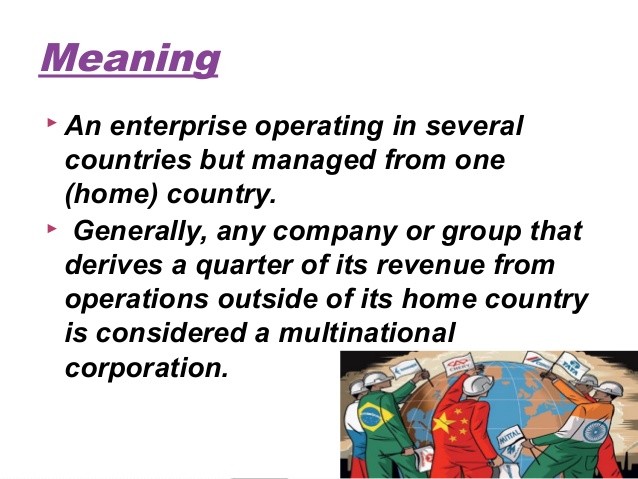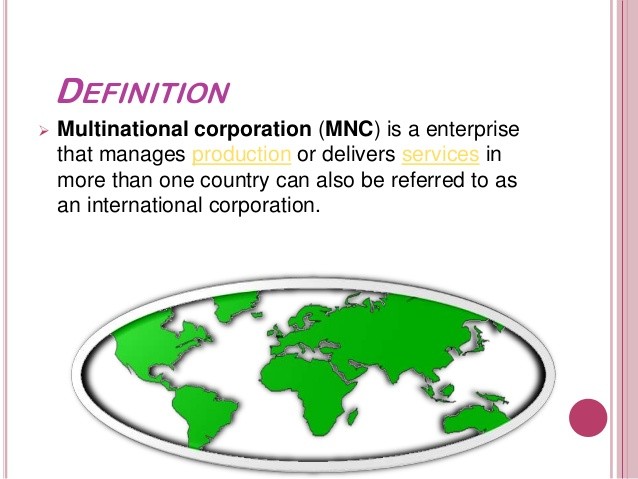Multinational corporations Characteristics and significance of MNCs
Post on: 16 Март, 2015 No Comment

Multinational corporations (MNCs in short) are also known as Transnational Corporations (TNCs), Super National Enterprises, Global companies, cosmocorps and so on.
According to Prof. John H. Dunning, A multinational enterprise is one which undertakes foreign direct investment, i.e., which owns or controls income gathering assets in more than one country; and in so doing produces goods or services outside its country of origin, i.e. engages in international production.
A multinational corporation has also been defined as an enterprise: which owns and/or controls producing facilities in more than one country such as factories, mines, oil refineries, distribution channels, offices, etc.’
According to another definition, Any business corporation in which ownership, management, production and marketing extend over several national jurisdictions is called a multinational corporation. Today, in international economic affairs they constitute the most important institutions. There are four participants in the drama of multinationals. First, the MNCs themselves; secondly, the host countries ; thirdly, the home countries ; and fourthly, the international community.
Characteristics of multinational corporations (MNCs):
The multinational corporations have certain characteristics which may be discussed below :
(1) Giant Size :
The most important feature of these MNCs is their gigantic size. Their assets and sales run into billions of dollars and they also make supernormal profits. According to one definition an MNC is one with a sales turnover of f 100 million. The MNCs are also super powerful organisations. In 1971 out of the top ninety producers of wealth, as many as 29 were MNCs, and the rest, nations. Besides the operations, most of these multinationals are spread in a vast number of countries. For instance, in 1973 out of a total of (,000 firms identified nearly 45 per cent had affiliates in more than 20 countries.
A Fundamental feature of a multinational corporation is that in such a corporation, control resides in the hands of a single institution. But its interests and operations sprawl across national boundaries. The Pepsi Cola company of the U.S operates in 114 countries. An MNC operates through a parent corporation in the home country. It may assume the form or a subsidiary in the host country. If it is a branch, it acts for the parent corporation without any local capital or management assistance. If it is a subsidiary, the majority control is still exercised by the foreign parent company, although it is incorporated in the host country. The foreign control may range anywhere between the minimum of 51 per cent to the full, 100 per cent. An MNC thus combines ownership with control. The branches and subsidiaries of MNCs operate under the unified control of the parent company.
Through the process of merger and takeover, etc. in course of time an MNC comes to assume awesome power. This coupled with its giant size makes it oligopolistic in character. So it enjoys a huge amount of profit. This oligopolistic structure has been the cause of a number of evils of the multinational corporations.
One thing to be observed in the case of the MNCs is that they have usually grown in a spontaneous and unconscious manner. Very often they developed through Creeping incrementalism. Many firms become multinationals by accident. Sometimes a firm established a subsidiary abroad due to wage differentials and better opportunity prevailing in the host country.
(5) Collective Transfer of Resources :
An MNC facilitates multilateral transfer of resources Usually this transfer takes place in the form of a package which includes technical know-how, equipment’s and machinery, materials, finished products, managerial services, and soon, MNCs are composed of a complex of widely varied modern technology ranging from production and marketing to management and financing. B.N. Ganguly has remarked in the case of an MNG resources are transferred, but not traded in, according to the traditional norms and practices of international trade.
(6) American dominance :

Another important feature of the world of multinationals is the American dominance. In 1971, out of the top 25 MNCs, as many as 18 were of U.S. origin. In that year the U.S. held 52 per cent of the total stock of direct foreign private investment. The U.E. has assumed more of the role of a foreign investor than the traditional exporter of home products.
Significance of multinational corporations (MNCs):
The multinational corporations today have a revolutionary effect on the international economic system. It is so because the growth of international transactions of the multinationals has affected the more traditional forms of capital flows and international trade for many economies. Today they constitute a powerful force in the world economy.
The value of the products sold by the MNCs in 1971 was more than $ 500 billion which was about one-fifth of the GNP of the entire world, excepting that of socialist economies. In the host countries, the volume of their production was about $ 330 billion. The present growth rate of their output in the host countries is a spectacular 10 per cent per annum which is almost double the growth rate of the world GNP.
In the field of international trade and international finance, the multinational firms have come to exercise enormous power. In early seventies the MNCs accounted for about one-eighth of all international trade- From the nature of their growth it may be presumed that in the early eighties their share will rise to one-fourth.
Among the developing countries only India had an annual income twice that of General Motors, which is the biggest multinational corporation. Otherwise the annual income of the other less developed countries is much less than that of the giant MNCs. By their sheer size the MNGs can disrupt the economies of the less developed countries, and may even threaten their political sovereignty.
We may comprehend the relative economic power of the MNCs vis-a-vis the nation-states by ranking them together according to gross annual sales and gross national product respectively. As Lester R. Brown has shown, out of 100 entries in the merged list 56 were nation-states and as many as 44 were MNCs.
According to one estimate by early eighties some 300 large MNCs will come to control 75 per cent of the world’s manufacturing assets.














